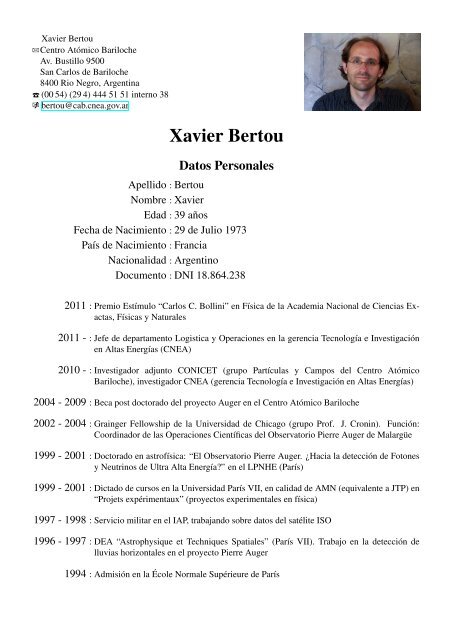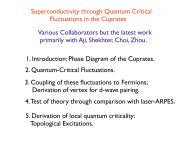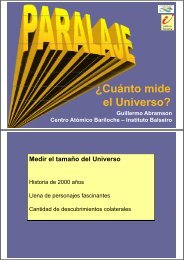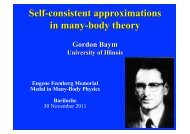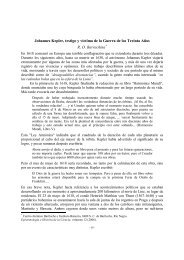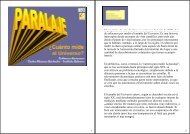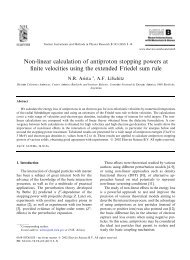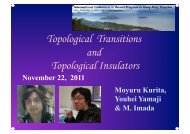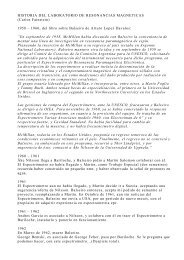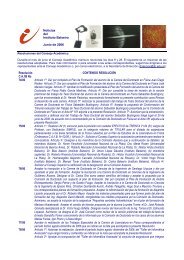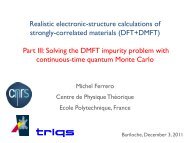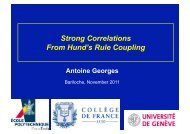CV - Xavier Bertou - CNEA
CV - Xavier Bertou - CNEA
CV - Xavier Bertou - CNEA
Create successful ePaper yourself
Turn your PDF publications into a flip-book with our unique Google optimized e-Paper software.
<strong>Xavier</strong> <strong>Bertou</strong><br />
BCentro Atómico Bariloche<br />
Av. Bustillo 9500<br />
San Carlos de Bariloche<br />
8400 Rio Negro, Argentina<br />
T (00 54) (29 4) 444 51 51 interno 38<br />
k bertou@cab.cnea.gov.ar<br />
<strong>Xavier</strong> <strong>Bertou</strong><br />
Datos Personales<br />
Apellido : <strong>Bertou</strong><br />
Nombre : <strong>Xavier</strong><br />
Edad : 39 años<br />
Fecha de Nacimiento : 29 de Julio 1973<br />
País de Nacimiento : Francia<br />
Nacionalidad : Argentino<br />
Documento : DNI 18.864.238<br />
2011 : Premio Estímulo “Carlos C. Bollini” en Física de la Academia Nacional de Ciencias Exactas,<br />
Físicas y Naturales<br />
2011 - : Jefe de departamento Logistica y Operaciones en la gerencia Tecnología e Investigación<br />
en Altas Energías (<strong>CNEA</strong>)<br />
2010 - : Investigador adjunto CONICET (grupo Partículas y Campos del Centro Atómico<br />
Bariloche), investigador <strong>CNEA</strong> (gerencia Tecnología e Investigación en Altas Energías)<br />
2004 - 2009 : Beca post doctorado del proyecto Auger en el Centro Atómico Bariloche<br />
2002 - 2004 : Grainger Fellowship de la Universidad de Chicago (grupo Prof. J. Cronin). Función:<br />
Coordinador de las Operaciones Científicas del Observatorio Pierre Auger de Malargüe<br />
1999 - 2001 : Doctorado en astrofísica: “El Observatorio Pierre Auger. ¿Hacia la detección de Fotones<br />
y Neutrinos de Ultra Alta Energía?” en el LPNHE (París)<br />
1999 - 2001 : Dictado de cursos en la Universidad París VII, en calidad de AMN (equivalente a JTP) en<br />
“Projets expérimentaux” (proyectos experimentales en física)<br />
1997 - 1998 : Servicio militar en el IAP, trabajando sobre datos del satélite ISO<br />
1996 - 1997 : DEA “Astrophysique et Techniques Spatiales” (París VII). Trabajo en la detección de<br />
lluvias horizontales en el proyecto Pierre Auger<br />
1994 : Admisión en la École Normale Supérieure de París
Título : Doctor en Astrofísica de la Universidad París VII<br />
Idiomas : Castellano (fluído), Frances (nativo), Ingles (fluído)<br />
Programación : C, C++, Fortran, Perl, herramientas del CERN: PAW, ROOT<br />
Observatorio Pierre Auger<br />
Proyectos de investigación<br />
Más información en www.auger.org y www.auger.org.ar.<br />
⊲ Responsable de la calibración de los detectores de surperficie (DS)<br />
⊲ Trabajo en selección de los eventos del DS y su reconstrucción<br />
⊲ Responsable de la publicación a fines educativas del 1% de los datos del DS<br />
⊲ Responsable en física solar, atmosférica y de rayos cósmicos de baja energía<br />
Proyecto Large Aperture GRB Observatory (LAGO)<br />
ver particulas.cnea.gov.ar/experiments/lago.<br />
⊲ Investigador Principal<br />
⊲ Detección de GRB por el método de las partículas individuales<br />
⊲ Programación de adquisición local (electrónica) y central<br />
⊲ Estudios de física solar con los datos de LAGO<br />
Laboratorio Subterráneo ANDES<br />
⊲ Impulsor de la propuesta<br />
⊲ Coordinador del comité directivo internacional<br />
ver andeslab.org.<br />
Actividades académicas<br />
⊲ Jurado de doctorado: Javier Tiffenberg (UBA, 2011)<br />
⊲ Revisor de doctorado: Geraldina Golup (IB, 2012)<br />
⊲ Jurado de Maestría: Andrés Felipe Rivera Romero (IB 2009), Jimmy Masías Meza (IB 2011, director),<br />
Manuel Gonzalez (IB 2012)<br />
⊲ Jurado de Licenciatura: Jimmy Masías Meza (IB 2010, director), Manuel Gonzalez (IB 2011)<br />
⊲ Referee en revistas internacionales<br />
⊲ Evaluador de proyectos e ingresos (ANR - Francia, CONACYT - México, CONICET, ANPCyT)
Síntesis de la actuación profesional<br />
Mi actividad científica se centra en el estudio de los rayos cósmicos, principalmente dentro del Observatorio<br />
Pierre Auger, y en la búsqueda de materia oscura en experimentos subterráneos.<br />
Ingresé a la colaboración Pierre Auger en 1996, cuando el proyecto todavía carecía de financiamento,<br />
y mis primeros estudios se focalizaron en la identificación de partículas exóticas, neutrinos y fotones,<br />
como rayos cósmicos de ultra alta energía. Esa identificación es primordial ya que permite separar los<br />
dos tipos de modelos de producción de rayos cósmicos: el “bottom-up”, en el cual las partículas son<br />
aceleradas en sitios astrofísicos (con lo cual no se esperan flujos altos de exóticos), y el “top-down”, en<br />
el cual los rayos cósmicos son producidos por “nueva” física (partículas super masivas del Big-Bang,<br />
defectos topológicos). Ese trabajo terminó en dos publicaciones muy aceptadas y referenciadas en el<br />
tema (más de 100 citas para el artículo sobre los neutrinos ν τ ).<br />
La parte técnica de mi tesis se concentró en el diseño y la implementación del sistema de adquisición<br />
centralizado (CDAS) de los detectores de superficie (DS) del Observatorio Pierre Auger, elemento<br />
principal de la detección de rayos cósmicos en el Observatorio. Desarrolle especificamente el sistema<br />
de disparo central que identifica los eventos producidos por rayos cósmicos, la interfaz con los detectores<br />
de fluorecencia, complementarios de los DS para una buena reconstrucción de los eventos, y el<br />
sistema de comunicación interno entre los varios procesos del CDAS.<br />
Al finalizar mi tesis, pasé varios meses en el sitio del Observatorio en construcción, en Malargüe, y<br />
decidí participar de la fase prototipo en el sitio mismo. J. Cronin me propuso una beca Grainger de la<br />
universidad de Chicago para ese trabajo, y pasé dos años en Malargüe. Fui nombrado coordinador de<br />
operaciones científicas, responsable de la operación de los DS. El contacto directo con el experimento<br />
y sus detectores me hizo concentrar en la calibración y el monitoreo del DS, y realicé los códigos<br />
de calibración automática de los detectores, elemento fundamental de la estabilidad de la toma de<br />
datos de Auger. Fui nombrado responsable de la calibración del DS, y la colaboración me eligió para<br />
una presentación oral del tema en la International Cosmic Ray Conference (ICRC) de Tsukuba, en<br />
2003. Fui encargado de la redacción de los capítulos 3 (Surface detectors of the engineering array) y<br />
7.1 (Events recorded with the Surface Detector) de la primera publicación de la colaboración entera,<br />
“Properties and performance of the prototype instrument for the Pierre Auger Observatory”, y presenté<br />
en forma oral en la ICRC siguiente (Pune, 2005) el funcionamiento del DS.<br />
Al dejar Malargüe en el 2004 para ir al Centro Atómico Bariloche focalicé mis esfuerzos en el análisis<br />
de los datos del DS, y desarrollé el método de selección de eventos físicos llamado “bottom-up”, lo<br />
cual rechaza detectores en coincidencias accidentales. Trabajé en el monitoreo de los detectores y su<br />
calibración offline, asi como en varios temas de reconstrucción, por lo cual fui designado responsable<br />
de la reconstrucción del DS, asi que del monitoreo de la estabilidad de los DS. Fui tambien designado<br />
responsable de la publicación del 1% de los datos del DS a fines educativas, y desarrolle un sitio<br />
internet a tal efecto (auger.colostate.edu/ED), en operación desde el 2008. Programé en 2005 un<br />
modo Geiger de toma de datos de los DS para el estudio de Destellos Gamma (GRB), e inicié en 2009<br />
un grupo de estudio de física de rayos cósmicos de baja energía dentro de Auger, con especial enfoque<br />
a la física solar, atmosférica, y GRB, en base al análisis de esos datos.
Síntesis de la actuación profesional (continúa)<br />
Dados los recientes resultados del Observatorio Pierre Auger – presencia de un corte en el espectro a<br />
altas energías, correlación entre los eventos de más alta energía y la distribución cercana de objetos<br />
extra galácticos – y la posibilidad concreta por primera vez de hacer astronomía con rayos cósmicos,<br />
resulta cada vez más importante estudiar la composición de los rayos cósmicos. Estoy por lo tanto<br />
coordinando el desarrollo de un detector complementario de los DS del Auger pero optimizado para<br />
medir composición a las más altas energías. El diseño modular adoptado permitirá agregar sensores a<br />
futuro, cosa muy dificil con el diseño adoptado en el Auger.<br />
Desde mitad del 2009, estoy involucrado en el proyecto ACTA, un conjunto de instrumentos científicos<br />
previstos para volar en los satelites ARSAT. Dentro de ACTA, soy co-responsable del detector FOG,<br />
por Fluorecencia desde Orbita Geoestacionaria, el cual consiste en medir la luz de fluorecencia terreste<br />
desde el espacio, estudiando sus fluctuaciones (ruido de fondo para observaciones de rayos cósmicos<br />
desde el espacio por JEM-EUSO o detectores similares), asi como destellos UV cuya origen queda<br />
desconocida. Detectores como JEM-EUSO podrían ser el futuro de los detectores de rayos cósmicos<br />
de las más altas energías.<br />
Otro nuevo detector potencial para los rayos cósmicos de las más altas energías sería un telescopio<br />
observando el bremsstrahlung molecular de un chubasco atmosférico de rayo cósmico (en microondas).<br />
Estoy participando de los dos principales proyectos en ese tema (AMBER y MIDAS), y<br />
liderando un esfuerzo similar para desarrollar una cámara micro-onda en el Centro Atómico Bariloche<br />
desde mitad del 2010.<br />
Al estudiar la detección de GRB con Auger en el 2005, simulaciones mostraron el potencial de unos<br />
pocos detectores Cherenkov situados a gran altura (más de 4500 m s.n.m.). Decidí por lo tanto en el<br />
2005 montar el proyecto LAGO con científicos de México y Bolivia, proyecto del cual soy el principal<br />
investigador desde su inicio. Desarrollé la adquisición local (en base a un FPGA) y central de LAGO,<br />
y el proyecto está ahora tomando datos, que presenté en las dos ultimas ICRC (Mexico 2007 y Polonia<br />
2009) y los dos ultimos RICH (Italia 2007 y Francia 2010). A fines del 2007 se sumaron cientificos<br />
de Venezuela al proyecto LAGO y montamos un detector en la Universidad de Los Andes (ULA) en<br />
Mérida, Venezuela. De Abril a Noviembre 2008, 2 estudiantes de licenciatura de la ULA estuvieron<br />
en formación bajo mi supervisión en el Centro Atómico Bariloche. En el 2009 se sumaron Perú<br />
y Colombia a la colaboración LAGO. En 2010 montamos el primer detector en Marcapomacocha,<br />
Perú y agregamos a Guatemala a la colaboración. Em 2011, se sumó Ecuador. El proyecto LAGO<br />
fue reconocido de interés científico, académico y social por la Legislatura de Río Negro (declaración<br />
42-2010), fue seleccionado como uno de los 8 proyectos latinoamericanos ganadores del concurso<br />
COMCLARA2010, renovado para COMCLARA2011, ganó el 1er Concurso CLARA - ALICE2 de<br />
Estudios de Caso, y recibió un subsidio Network del ICTP en el 2010. Para el 2013, tenemos previsto<br />
preparar un detector para su instalación en la base Marambio en la Antartida, con la colaboración del<br />
Instituto Antártico Argentino, para estudiar la actividad solar con bajo umbral geomagnético.<br />
Del 11 al 22 de enero de 2010, dirigí la “XI ICFA School on Instrumentation in Elementary Particle<br />
Physics”, una escuela única en su genero por permitir a los estudiantes trabajar en talleres experimentales<br />
con equipos de detección de partículas traidos del CERN y de Fermilab. Participaron más de<br />
30 profesionales de estos centros y más de 80 estudiantes de todo el mundo (de los cuales más de 20<br />
Argentinos).
Síntesis de la actuación profesional (continúa)<br />
Coordiné en el 2010 un esfuerzo de las gerencias de la <strong>CNEA</strong> Tecnología e Investigación en Altas Energías,<br />
Coordinación del Centro Atómico Bariloche (CAB) y gerencia Física del CAB para la creación<br />
del Laboratorio Detección de Partículas y Radiación en el CAB (LabDPR), la cual se concretó en julio<br />
de 2010. Estoy dirigiendo el LabDPR y se contrataron 2 ingenieros electrónicos para los desarrollos<br />
necesarios en los proyectos mencionados anteriormente.<br />
Finalmente, inicié en agosto de 2010 el proyecto de un laboratorio subterráneo al enterarme de la<br />
posible construcción del túnel Agua Negra en la provincia de San Juan. Me familiaricé con el tema<br />
visitando otros laboratorios subterráneos (Gran Sasso y Modane) y reuniendome con directores de<br />
los centros europeos. Contacté la empresa Geoconsult Buenos Aires SA a cargo del proyecto del<br />
túnel Agua Negra con la cual estamos preparando el estudio de factibilidad del laboratorio ANDES,<br />
un laboratorio de 65 000 m 3 1750 m bajo tierra, e inicié un potencial Consorcio Latinoamericano de<br />
Experimentos Subterráneos con contactos en Chile, Brasil y México. Organicé el First International<br />
Workshop for the Design of the ANDES Underground Laboratory en Abril de 2011 en Buenos Aires,<br />
en el cual se decidió formar un comité directivo con un representante por país, del cual soy el coordinador.<br />
En marzo del 2012 el proyecto ANDES recibió dictamen favorable de la Comisión Asesora Grandes<br />
Instrumentos del MinCyT, y fue apoyado por la Entidad Binacional Túnel Agua Negra. Considerando<br />
probable la futura construcción del laboratorio, empece el proyecto de desarrollar un detector de materia<br />
oscura en el laboratorio Detección de Partículas y Radiación, en colaboración con científicos del<br />
Fermilab, de México (ICN-UNAM) y de Chile (UTFSM). El proyecto consiste en operar un detector<br />
en base a CCD, similar al experimento DAMIC de Fermilab, en el hemisferio Sur. Se tratará primero<br />
de armar un prototipo en el laboratorio, y luego operarlo en una mina en la región, posiblemente<br />
Mina Aguilar en Jujuy, Sierra Grande en Río Negro, o El Teniente en Chile. Desde fines del 2012<br />
el Ing. Miguel Sofo Haro está haciendo un trabajo de tesis de doctorado con estos CCD. A futuro se<br />
construiría un detector masivo en base a esa tecnología para operarlo en ANDES.
Publicaciones en Revistas con Referato<br />
⊲ The Pierre Auger Collaboration<br />
Bounds on the density of sources of ultra-high energy cosmic rays from the Pierre Auger Observatory<br />
JCAP 1305:009, 2013<br />
⊲ The Pierre Auger Collaboration<br />
Ultrahigh Energy Neutrinos at the Pierre Auger Observatory<br />
Adv.High Energy Phys. 2013:708680, 2013<br />
⊲ The Pierre Auger Collaboration<br />
Techniques for Measuring Aerosol Attenuation using the Central Laser Facility at the Pierre Auger<br />
Observatory<br />
JINST 8:P04009, 2013<br />
⊲ The Pierre Auger Collaboration<br />
Interpretation of the Depths of Maximum of Extensive Air Showers Measured by the Pierre Auger<br />
Observatory<br />
JCAP 1302:026, 2013<br />
⊲ The Pierre Auger Collaboration<br />
Constraints on the origin of cosmic rays above 10 18 eV from large scale anisotropy searches in data<br />
of the Pierre Auger Observatory<br />
Astrophys.J. 762:L13, 2012<br />
⊲ The Pierre Auger Collaboration<br />
A Search for Point Sources of EeV Neutrons<br />
Astrophys.J. 760:148, 2012<br />
⊲ The Pierre Auger Collaboration<br />
Results of a self-triggered prototype system for radio-detection of extensive air showers at the Pierre<br />
Auger Observatory<br />
JINST 7:P11023, 2012<br />
⊲ X. <strong>Bertou</strong><br />
The ANDES underground laboratory<br />
Eur.Phys.J.Plus 127:104, 2012<br />
⊲ The Pierre Auger Collaboration<br />
Large scale distribution of arrival directions of cosmic rays detected above 10 18 eV at the Pierre<br />
Auger Observatory<br />
Astrophys.J.Suppl. 203:34, 2012<br />
⊲ The Pierre Auger Collaboration<br />
Search for Point-Like Sources of Ultra-High Energy Neutrinos at the Pierre Auger Observatory and<br />
Improved Limit on the Diffuse Flux of Tau Neutrinos<br />
Astrophys.J. 755:L4, 2012<br />
⊲ The Pierre Auger Collaboration<br />
Antennas for the Detection of Radio Emission Pulses from Cosmic-Ray<br />
JINST 7:P10011, 2012<br />
⊲ The Pierre Auger Collaboration<br />
The Rapid Atmospheric Monitoring System of the Pierre Auger Observatory<br />
JINST 7:P09001, 2012
Publicaciones en Revistas con Referato (continúa)<br />
⊲ The Pierre Auger Collaboration<br />
Measurement of the proton-air cross-section at sqrts = 57 TeV with the Pierre Auger Observatory<br />
Phys.Rev.Lett. 109:062002, 2012<br />
⊲ The Pierre Auger Collaboration<br />
Measurement of the Cosmic Ray Energy Spectrum Using Hybrid Events of the Pierre Auger Observatory<br />
Eur.Phys.J.Plus 127:87, 2012<br />
⊲ The Pierre Auger Collaboration<br />
A search for anisotropy in the arrival directions of ultra high energy cosmic rays recorded at the<br />
Pierre Auger Observatory<br />
JCAP 1204:040, 2012<br />
⊲ The Pierre Auger Collaboration<br />
Description of Atmospheric Conditions at the Pierre Auger Observatory using the Global Data Assimilation<br />
System (GDAS)<br />
Astropart.Phys. 35:591-607, 2012<br />
⊲ The Pierre Auger Collaboration<br />
Search for signatures of magnetically-induced alignment in the arrival directions measured by the<br />
Pierre Auger Observatory<br />
Astropart.Phys. 35:354-361, 2012<br />
⊲ The Pierre Auger Collaboration<br />
Advanced functionality for radio analysis in the Offline software framework of the Pierre Auger<br />
Observatory<br />
Nucl.Instrum.Meth. A635:92-102, 2011<br />
⊲ The Pierre Auger Collaboration<br />
The effect of the geomagnetic field on cosmic ray energy estimates and large scale anisotropy<br />
searches on data from the Pierre Auger Observatory<br />
JCAP 1111:022, 2011<br />
⊲ X. <strong>Bertou</strong><br />
El laboratorio subterráneo ANDES<br />
Anales Acad. Nac. de Cs. Ex., Fís. y Nat. 63:67-70, 2011<br />
⊲ The Pierre Auger Collaboration<br />
A Search for Ultra-High Energy Neutrinos in Highly Inclined Events at the Pierre Auger Observatory<br />
Phys.Rev. D 84:122005, 2011<br />
⊲ The Pierre Auger Collaboration<br />
The Lateral Trigger Probability function for the ultra-high energy cosmic ray showers detected by<br />
the Pierre Auger Observatory<br />
Astropart. Phys. 35:266-276, 2011<br />
⊲ P. Facal et al.<br />
Microwave detection of air showers with MIDAS<br />
Nucl. Instrum. Meth. A662:118-123, 2012<br />
⊲ X. <strong>Bertou</strong> for the Pierre Auger Collaboration<br />
Background radiation measurement with water Cherenkov detectors<br />
Nucl. Instrum. Meth. A639:73-76, 2011
Publicaciones en Revistas con Referato (continúa)<br />
⊲ The Pierre Auger Collaboration<br />
Anisotropy and chemical composition of ultra-high energy cosmic rays using arrival directions measured<br />
by the Pierre Auger Observatory<br />
JCAP 1106:022, 2011<br />
⊲ The Pierre Auger Collaboration<br />
Search for First Harmonic Modulation in the Right Ascension Distribution of Cosmic Rays Detected<br />
at the Pierre Auger Observatory.<br />
Astropart. Phys. 34:627-639, 2011<br />
⊲ The Pierre Auger Collaboration<br />
The Pierre Auger Observatory Scaler Mode for the Study of Solar Activity Modulation of Galactic<br />
Cosmic Rays<br />
JInst. 6:P01003, 2011<br />
⊲ The Pierre Auger Collaboration<br />
The exposure of the hybrid detector of the Pierre Auger Observatory<br />
Astropart. Phys. 34:368-381, 2010<br />
⊲ The Pierre Auger Collaboration<br />
Update on the correlation of the highest energy cosmic rays with nearby extragalactic matter<br />
Astropart. Phys. 34:314-326, 2010<br />
⊲ The Pierre Auger Collaboration<br />
The Fluorescence Detector of the Pierre Auger Observatory<br />
Nucl. Instrum. Meth. A620:227-251, 2010<br />
⊲ The Pierre Auger Collaboration<br />
The Northern Site of the Pierre Auger Observatory<br />
New Journ. Physics 12:035001,2010<br />
⊲ The Pierre Auger Collaboration<br />
A study of the effects of Molecular and Aerosol conditions in the atmosphere on Air Fluorescence<br />
measurements at the Pierre Auger Observatory<br />
Astropart. Phys. 33:108,2010<br />
⊲ The Pierre Auger Collaboration<br />
Measurement of the energy spectrum of cosmic rays above 10 18<br />
Observatory<br />
Phys. Let. B 685:239,2010<br />
eV using the Pierre Auger<br />
⊲ The Pierre Auger Collaboration<br />
Measurement of the Depth of Maximum of Extensive Air Showers above 10 18 eV<br />
Phys. Rev. Let. 104:091101,2010<br />
⊲ The Pierre Auger Collaboration<br />
Trigger and Aperture of the Surface Detector Array of the Pierre Auger Observatory<br />
Nucl. Instrum. Meth. A613:29-39, 2010<br />
⊲ The Pierre Auger Collaboration<br />
Atmospheric effects on extensive air showers observed with the Surface Detector of the Pierre Auger<br />
Observatory.<br />
Astropart. Phys. 32:89-99,2009
Publicaciones en Revistas con Referato (continúa)<br />
⊲ The Pierre Auger Collaboration<br />
Limit on the diffuse flux of ultra-high energy tau neutrinos with the surface detector of the Pierre<br />
Auger Observatory.<br />
Phys. Rev. D 79:102001, 2009.<br />
⊲ The Pierre Auger Collaboration<br />
Upper limit on the cosmic-ray photon fraction at EeV energies from the Pierre Auger Observatory.<br />
Astropart. Phys. 31:399-406, 2009.<br />
⊲ D. Allard et al. (LAGO Collaboration)<br />
Use of water-Cherenkov detectors to detect Gamma Ray Bursts at the Large Aperture GRB<br />
Observatory (LAGO)<br />
Nucl. Instrum. Meth. A595:70–72, 2008.<br />
⊲ The Pierre Auger Collaboration<br />
Observation of the Suppression of the Flux of Cosmic Rays above 4 × 10 19 eV.<br />
Phys. Rev. Letters 101:061101, 2008.<br />
⊲ The Pierre Auger Collaboration<br />
Upper limit on the diffuse flux of UHE tau neutrinos from the Pierre Auger Observatory.<br />
Phys. Rev. Letters 100:21101, 2008.<br />
⊲ The Pierre Auger Collaboration<br />
Correlation of the highest-energy cosmic rays with the positions of nearby active galactic nuclei.<br />
Astropart. Phys. 29:188-204, 2008.<br />
⊲ The Pierre Auger Collaboration<br />
Upper limit on the cosmic-ray photon flux above 10 19 eV using the surface detector of the Pierre<br />
Auger Observatory.<br />
Astropart. Phys. 29:243-256, 2008.<br />
⊲ The Pierre Auger Collaboration<br />
Correlation of the highest energy cosmic rays with nearby extragalactic objects.<br />
Science 318:939-943, 2007.<br />
⊲ The Pierre Auger Collaboration<br />
Anisotropy studies around the galactic centre at EeV energies with the Auger Observatory.<br />
Astropart. Phys. 27:244–253, 2007.<br />
⊲ The Pierre Auger Collaboration<br />
An upper limit to the photon fraction in cosmic rays above 10 19 eV from the Pierre Auger<br />
Observatory.<br />
Astropart. Phys. 27:155-168, 2007.<br />
⊲ X. <strong>Bertou</strong> et al.<br />
Calibration of the surface array of the Pierre Auger Observatory.<br />
Nucl. Instrum. Meth. A568:839–846, 2006.<br />
⊲ X. <strong>Bertou</strong> and D. Allard.<br />
Detection of grb with water cherenkov detectors.<br />
Nucl. Instrum. Meth. A553:299–303, 2005.
Publicaciones en Revistas con Referato (continúa)<br />
⊲ A. Etchegoyen et al.<br />
Muon-track studies in a water cherenkov detector.<br />
Nucl. Instrum. Meth. A545:602–612, 2005.<br />
⊲ The Pierre Auger Collaboration<br />
Properties and performance of the prototype instrument for the Pierre Auger Observatory.<br />
Nucl. Instrum. Meth. A523:50–95, 2004.<br />
⊲ A. Omont et al.<br />
ISOGAL: a deep survey of the obscured Milky Way with ISO at 7 µm and 15 µm and with DENIS<br />
in the near-infrared<br />
Astron. Astrophys. 403:975-992, 2003.<br />
⊲ X. <strong>Bertou</strong>, P. Billoir, O. Deligny, C. Lachaud, and A. Letessier-Selvon.<br />
Tau neutrinos in the Auger Observatory: A new window to UHECR sources.<br />
Astropart. Phys. 17:183–193, 2002.<br />
⊲ X. <strong>Bertou</strong>, P. Billoir, S. Dagoret-Campagne<br />
LPM effect and pair production in the geomagnetic field: a signature of ultra-high energy photons in<br />
the Pierre Auger Observatory<br />
Astropart. Phys. 14:121–130, 2000.<br />
⊲ X. <strong>Bertou</strong>, M. Boratav, and A. Letessier-Selvon.<br />
Physics of extremely high energy cosmic rays.<br />
Int. J. Mod. Phys. A15:2181–2224, 2000.<br />
⊲ A. Omont et al.<br />
Isogal-denis detection of red giants with weak mass loss in the galactic bulge.<br />
Astron. Astrophys. 348:755-767, 1999.<br />
Publicaciones en Congresos<br />
⊲ A. Etchegoyen, D. Ravignani, F. Sánchez and X. <strong>Bertou</strong><br />
The Non-Thermal Cosmic Messengers Universe<br />
Publicado en Proceedings of Primera Reunión Argentino-Brasileña de Gravitación, Astrofísica y Cosmología<br />
Foz de Iguazú, Brasil, 4-8 de Octubre, 2011<br />
⊲ The Pierre Auger Collaboration<br />
The Pierre Auger Observatory I: The Cosmic Ray Energy Spectrum and Related Measurements<br />
The Pierre Auger Observatory II: Studies of Cosmic Ray Composition and Hadronic Interaction models<br />
The Pierre Auger Observatory III: Other Astrophysical Observations<br />
The Pierre Auger Observatory IV: Operation and Monitoring<br />
The Pierre Auger Observatory V: Enhancements<br />
Preparado para el 32nd International Cosmic Ray Conference, Bejing, China, 2011<br />
⊲ X. <strong>Bertou</strong> for the LAGO Collaboration<br />
The Large Aperture GRB Observatory<br />
Publicado en Proceedings of Science CRA School 036, 4th School on Cosmic Rays and Astrophysics,<br />
Sao Paulo, Brazil, 2010
Publicaciones en Congresos (continúa)<br />
⊲ C. Williams et al.<br />
The MIDAS Experiment: A New Technique for the Detection of Extensive Air Showers<br />
Preparado para el XVI International Symposium on Very High Energy Cosmic Ray Interactions<br />
(ISVHECRI 2010), Batavia, USA, 2010<br />
⊲ M. Monasor et al.<br />
The MIDAS experiment: A prototype for the microwave emission of Ultra-High Energy Cosmic Rays<br />
Publicado en proceedings of 12th Topical Seminar on Innovative Particle and Radiation Detectors<br />
(IPRD10), Siena, Italy, 2010<br />
⊲ the Pierre Auger Collaboration<br />
Calibration and Monitoring of the Pierre Auger Observatory.<br />
Preparado para la 31st International Cosmic Ray Conference, Lodz, Poland, 2009<br />
⊲ the Pierre Auger Collaboration<br />
Operations of and Future Plans for the Pierre Auger Observatory.<br />
Preparado para la 31st International Cosmic Ray Conference, Lodz, Poland, 2009<br />
⊲ the Pierre Auger Collaboration<br />
Astrophysical Sources of Cosmic Rays and Related Measurements with the Pierre Auger Observatory.<br />
Preparado para la 31st International Cosmic Ray Conference, Lodz, Poland, 2009<br />
⊲ the Pierre Auger Collaboration<br />
Studies of Cosmic Ray Composition and Air Shower Structure with the Pierre Auger Observatory.<br />
Preparado para la 31st International Cosmic Ray Conference, Lodz, Poland, 2009<br />
⊲ the Pierre Auger Collaboration<br />
The Cosmic Ray Energy Spectrum and Related Measurements with the Pierre Auger Observatory.<br />
Preparado para la 31st International Cosmic Ray Conference, Lodz, Poland, 2009<br />
⊲ the LAGO Collaboration<br />
Water Cherenkov Detectors response to a Gamma Ray Burst in the Large Aperture GRB Observatory.<br />
Preparado para la 31st International Cosmic Ray Conference, Lodz, Poland, 2009<br />
⊲ the LAGO Collaboration<br />
The Large Aperture GRB Observatory.<br />
Preparado para la 31st International Cosmic Ray Conference, Lodz, Poland, 2009<br />
⊲ the LAGO Collaboration<br />
Operating Water Cherenkov Detectors in high altitude sites for the Large Aperture GRB Observatory.<br />
Preparado para la 31st International Cosmic Ray Conference, Lodz, Poland, 2009<br />
⊲ X. <strong>Bertou</strong> for the LAGO Collaboration<br />
The Large Aperture GRB Observatory<br />
AIP Conf.Proc. 1123:197-203, 2009.<br />
⊲ A.C. Rovero et al.<br />
Sites for Gamma-ray Astronomy in Argentina<br />
AIP Conf.Proc. 1085:870–873, 2009.<br />
⊲ X. <strong>Bertou</strong><br />
Detection of GRBs in Auger and the LAGO project.<br />
Preparado para el 6th Latin American Symposium on High Energy Physics (VI-Silafae), Puerto Vallarta,<br />
Mexico, 1-8 Nov 2006. Publicado en AIP Conf.Proc.917:195-201, 2007.
Publicaciones en Congresos (continúa)<br />
⊲ The Pierre Auger Collaboration, X. <strong>Bertou</strong><br />
Search for Gamma Ray Bursts using the single particle technique at the Pierre Auger Observatory<br />
Preparado para la 30th International Cosmic Ray Conference, Mérida, Mexico, 3-11 Jul 2007.<br />
⊲ X. <strong>Bertou</strong> et al.<br />
Looking for the high energy component of GRBs at the Large Aperture GRB Observatory<br />
Preparado para la 30th International Cosmic Ray Conference, Mérida, Mexico, 3-11 Jul 2007.<br />
⊲ D. Allard et al.<br />
The Large Aperture GRB Observatory<br />
Actas del Workshop Astronomía Observacional en Argentina: Problemas y Perspectivas, 2006<br />
⊲ X. <strong>Bertou</strong>.<br />
Performance of the Pierre Auger Observatory surface array.<br />
Preparado para la 29th International Cosmic Ray Conference, Pune, India, 3-11 Aug 2005.<br />
⊲ D. Allard et al.<br />
Aperture calculation of the Pierre Auger Observatory surface detector.<br />
Preparado para la 29th International Cosmic Ray Conference, Pune, India, 3-11 Aug 2005.<br />
⊲ D. Allard et al.<br />
The trigger system of the Pierre Auger surface detector: Operation, efficiency and stability.<br />
Preparado para la 29th International Cosmic Ray Conference, Pune, India, 3-11 Aug 2005.<br />
⊲ P. Allison et al.<br />
Timing calibration and synchronization of surface and fluorescence detectors of the Pierre Auger<br />
Observatory.<br />
Preparado para la 29th International Cosmic Ray Conference, Pune, India, 3-11 Aug 2005.<br />
⊲ I. Allekotte et al.<br />
Observation of the long term stability of water stations in the Pierre Auger surface detector.<br />
Preparado para la 29th International Cosmic Ray Conference, Pune, India, 3-11 Aug 2005.<br />
⊲ M. Aglietta et al.<br />
Response of the Pierre Auger Observatory water cherenkov detectors to muons.<br />
Preparado para la 29th International Cosmic Ray Conference, Pune, India, 3-11 Aug 2005.<br />
⊲ P. Allison et al.<br />
Observing muon decays in water cherenkov detectors at the pierre auger observatory.<br />
Preparado para la 29th International Cosmic Ray Conference, Pune, India, 3-11 Aug 2005.<br />
⊲ M. Aglietta et al.<br />
Calibration of the surface array of the Pierre Auger Observatory.<br />
Preparado para la 29th International Cosmic Ray Conference, Pune, India, 3-11 Aug 2005.<br />
⊲ D. Allard et al.<br />
Detecting gamma-ray bursts with the Pierre Auger Observatory using the single particle technique.<br />
Preparado para la 29th International Cosmic Ray Conference, Pune, India, 3-11 Aug 2005.<br />
⊲ X. <strong>Bertou</strong>.<br />
Calibration and monitoring of the Pierre Auger surface detectors.<br />
Preparado para la 28th International Cosmic Ray Conferences, Tsukuba, Japan, 31 Jul - 7 Aug 2003.
Publicaciones en Congresos (continúa)<br />
⊲ C. Lachaud, X. <strong>Bertou</strong>, P. Billoir, O. Deligny, and A. Letessier-Selvon.<br />
Probing the gzk barrier with uhe tau neutrinos.<br />
Nucl. Phys. Proc. Suppl., 110:525–527, 2002.<br />
⊲ A. Letessier-Selvon, X. <strong>Bertou</strong>, O. Deligny, and C. Lachaud.<br />
Neutrino sensitivity and background rejection of the auger observatory.<br />
Preparado para la 27th International Cosmic Ray Conference, Hamburg, Germany, 7-15 Aug 2001.<br />
⊲ P. Billoir, X. <strong>Bertou</strong>, O. Deligny, and A. Letessier-Selvon.<br />
Enhancement of neutrino detection with auger through oscillation.<br />
Preparado para la International Europhysics Conference on High-Energy Physics (HEP 2001), Budapest,<br />
Hungary, 12-18 Jul 2001.<br />
⊲ X. <strong>Bertou</strong>.<br />
Uhe neutrinos in auger.<br />
Preparado para las 21st Rencontres de Moriond Workshop on Very High-Energy Phenomena in the<br />
Universe, Les Arcs, France, 20-27 Jan 2001.<br />
⊲ S. Coutu, X. <strong>Bertou</strong>, and P. Billoir.<br />
Ultrahigh energy neutrinos with auger.<br />
Preparado para el 23rd Johns Hopkins Workshop on Current Problems in Particle Theory: Neutrinos<br />
in the New Millennium, Baltimore, Maryland, 10-12 Jun 1999.<br />
Escuelas y charlas públicas<br />
⊲ Charla invitada “GRB Observation with LAGO” a la “Fourth School on Cosmic Rays and Astrophysics,<br />
Santo André, Brazil”, del 25 de Agosto al 3 de Setiembre 2010.<br />
⊲ Director de la XI ICFA School on Instrumentation in Elementary Particle Physics, organizada en<br />
Bariloche del 11 al 22 de Enero del 2010.<br />
⊲ Miembro del comite local de organización del VII Simposio Latinoamericano de Física de Altas<br />
Energías & IX Simposio Argentino de Partículas y Campos, realizado en Bariloche, del 14 al 21 de<br />
Enero del 2009.<br />
⊲ Charlas invitadas “The Pierre Auger Observatory, latest results” y “The LAGO project, status and<br />
prospects” a la “Third School on Cosmic Rays and Astrophysics, Arequipa, Perú”, del 25 de Agosto<br />
al 5 de Setiembre 2008.<br />
⊲ Dictado de 4 h de curso “High Energy Astrophysics” en la Universidad Simon Bolivar, Caracas,<br />
Venezuela en Febrero 2008.<br />
⊲ Dictado de 1 h30 de curso “Cosmic Ray Detectors: Probes for the Highest Energies” en la Univerdidad<br />
de Los Andes, Mérida, Venezuela en agosto 2007.<br />
⊲ Dictado de 4 h de curso “Ultra High Energy Cosmic Rays: from Data to Physics” a la “Second School<br />
on Cosmic Rays and Astrophysics, Puebla, México”, del 30 de Agosto al 8 de Setiembre 2006.<br />
⊲ “Vacas, Vizcachas y Rayos Cosmicos en el Observatorio Pierre Auger”, charla gran público seguida<br />
de “Astrophysics with the Pierre Auger Observatory” en la ESO, 2 de Junio del 2004.
Notas GAP<br />
Las notas GAP son notas técnicas internas al Proyecto Pierre Auger.<br />
Los artículos públicos se pueden consultar en www.auger.org/admin/GAP Notes.<br />
1997-058 : X. <strong>Bertou</strong>, P. Billoir, T. Pradier<br />
Analysis of Quasi-horizontal Showers Detected in the Auger Ground Detector<br />
1998-049 : <strong>Xavier</strong> <strong>Bertou</strong> and Pierre Billoir<br />
Conversion of Ultra High Energy Photons in the Geomagentic Field: What can be Seen in<br />
Auger?<br />
1999-030 : Stephane Coutu, <strong>Xavier</strong> <strong>Bertou</strong>, Pierre Billoir<br />
Ultra-High Energy Neutrinos with Auger (To appear in the Proceedings of the 23rd Johns<br />
Hopkins Workshop on Current Problems in Particle Theory (Neutrinos in the Next Millenium),<br />
Baltimore, 1999)<br />
1999-039 : X. <strong>Bertou</strong>, P. Billoir, S. Dagoret-Campagne<br />
LMP Effect and Pair Production in the Geomagnetic Field: a signature of ultra high energy<br />
photons in the Pierre Auger Observatory<br />
2000-017 : X. <strong>Bertou</strong> and P. Billoir<br />
On the Origin of the Asymmetry of Ground Densities in Inclined Showers<br />
2001-028 : P. Billoir, X. <strong>Bertou</strong>, S. Dagoret-Campagne, A. Letessier-Selvon, B.Revenu<br />
Photon/Hadron Separation with the AUGER Observatory<br />
2002-019 : <strong>Xavier</strong> <strong>Bertou</strong><br />
L’Observatoire Pierre Auger. Vers la détection de Photons et Neutrinos à Ultra Haute Énergie?<br />
2002-028 : P.S. Allison, P. Bauleo, X. <strong>Bertou</strong>, C.B. Bonifazi<br />
Surface Detector calibration in the Engineering Array<br />
2002-074 : Pierre Billoir, Pierre Da Silva, <strong>Xavier</strong> <strong>Bertou</strong><br />
Checking the Origin of the Asymmetry of the Surface Detector Signals<br />
2003-005 : X. <strong>Bertou</strong>, C. Grunfeld, A. Chou<br />
Preliminary analysis of the Didi pre-production tank<br />
2003-046 : Cyril Lachaud and <strong>Xavier</strong> <strong>Bertou</strong><br />
Local Stations Trigger Monitoring Files<br />
2003-091 : Clementina Medina, <strong>Xavier</strong> <strong>Bertou</strong><br />
Water Level Experiment in Laura<br />
2003-113 : D. Supanitsky and X. <strong>Bertou</strong><br />
Semi-Analytical Model of the Three Fold Charge Spectrum in a Water Cerenkov Tank<br />
2004-001 : M. C. Medina, X. <strong>Bertou</strong>, C. Bonifazi, A. Filevich, D. Melo, D.Supanitsky, A. Tamashiro<br />
Sensitivity of muon data to the water level in a Water Cerenkov Detector<br />
2004-030 : Clementina Medina, <strong>Xavier</strong> <strong>Bertou</strong><br />
Using compact 3 TOT as a starting point for SD reconstruction<br />
2004-033 : P.S. Allison, X. <strong>Bertou</strong>, C. Grunfeld<br />
Pulse shape agnostic methods of measuring the dynode-anode ratio<br />
2004-049 : F . Arneodo , X. <strong>Bertou</strong> , N. Busca , P.L. Ghia<br />
Muon decays in the Auger production tanks and the Palauco water level experiment<br />
2004-051 : M. C.Medina, P. Billoir, J.C. Hamilton, X. <strong>Bertou</strong><br />
Analysis of 3 Fold Trigger Rate Dependence on Deviations from Ideal Geometry<br />
2005-012 : P.S. Allison, J.J. Beatty, X. <strong>Bertou</strong>, E. Parizot<br />
The Heartbeat of the Pierre Auger Project: Measuring the True Experimental Livetime<br />
2005-029 : X. <strong>Bertou</strong><br />
Improving the T4 by the Bottom Up tank selection<br />
2005-034 : X. <strong>Bertou</strong>, D. Harari, S. Mollerach, E. Roulet<br />
Rayleigh analysis of Auger SD events azimuth distribution<br />
2005-053 : X. <strong>Bertou</strong>, D. Allard<br />
Current status of the scalers: Towards the detection of GRBs with Auger?
Notas GAP (continúa)<br />
2005-059 : M. Gomez Berisso, I. Allekotte, X. <strong>Bertou</strong>, C. Medina<br />
Computation of the Auger surface detector trigger probability from real data<br />
2005-071 : X. <strong>Bertou</strong><br />
GPS glitches in Auger Surface Detectors<br />
2005-084 : H. Asorey, I. Allekotte, M. Gómez Berisso, X. <strong>Bertou</strong><br />
Robustness of the energy reconstruction with the Surface Array of the Auger Observatory<br />
2005-092 : M. Gomez Berisso, I. Allekotte, X. <strong>Bertou</strong>, M. C. Medina<br />
The Auger Surface Detector acceptance from real data<br />
2005-101 : D. Dornic, F. Arneodo, I. Lhenry-Yvon, X. <strong>Bertou</strong>, C. Bonifazi, P Ghia, C Grunfeld, T. Suomijarvi<br />
Calibration Analysis: CAPISA data<br />
2005-107 : H. Asorey, I. Allekotte, M. Gomez Berisso, X. <strong>Bertou</strong><br />
Robustness of the angular reconstruction with the Surface Array of the Auger Observatory.<br />
2006-052 : H. Asorey, X. <strong>Bertou</strong>, E. Roulet<br />
How to improve the SD arrival direction reconstruction by correcting the start-time of individual<br />
detectors<br />
2006-098 : X. <strong>Bertou</strong>, E. Roulet, S. Mollerach, E. Roulet<br />
On weather effects, how to account for them and large scale anisotropies<br />
2006-100 : X. <strong>Bertou</strong><br />
Analysis of the Auger scaler data in search for GRBs<br />
2007-047 : X. <strong>Bertou</strong>, D. Harari, S. Mollerach and E. Roulet<br />
Anisotropies from a tilted surface array<br />
2007-089 : X. <strong>Bertou</strong><br />
SDCast: the SD event broadcaster in CDAS<br />
2007-119 : X. <strong>Bertou</strong>, C. Grunfeld, R. Sato, F. Suarez<br />
Pulse Shapes Studies for raining PMTs<br />
2008-001 : X. <strong>Bertou</strong><br />
Effect of ground altitude on SD energy determination<br />
2008-057 : X. <strong>Bertou</strong><br />
Study of time delay to SD T3 decision<br />
2008-072 : H. Asorey, X. <strong>Bertou</strong><br />
First large timescale analysis of Auger SD scaler data: Towards cosmic ray Solar modulation<br />
studies<br />
2008-109 : X. <strong>Bertou</strong><br />
Calibrating an extended Dynamic Range for the Auger South Surface Detectors<br />
2008-112 : S. Grebe, I. Allekotte, H. Asorey, X. <strong>Bertou</strong>, P. Buchholz<br />
Robustness of the CDAS reconstruction algorithm<br />
2008-114 : I. Allekotte, H. Asorey, X. <strong>Bertou</strong>, M. Gómez Berisso<br />
You thought you understood hexagons?<br />
2008-117 : H. Asorey, X. <strong>Bertou</strong><br />
Determining the Dynamic Range needed for new Surface Detectors<br />
2008-156 : X. <strong>Bertou</strong><br />
Effect of wrong coordinates on the Surface Detector timing<br />
2009-099 : X. <strong>Bertou</strong><br />
Looking for correlation between lightning and UHECR<br />
2009-112 : I. Allekotte, H. Asorey, X. <strong>Bertou</strong>, M. Gómez Berisso<br />
Determining the acceptance of the Pierre Auger Surface Detector with the Infill Array<br />
2009-154 : H. Asorey, X. <strong>Bertou</strong>, D. Thomas, M. Mostafá<br />
The OMG Hybrid Event
Notas GAP (continúa)<br />
2009-155 : I. Allekotte, H. Asorey, X. <strong>Bertou</strong>, M. Gómez Berisso<br />
Acceptance of generalized Suface Detectors Arrays from real data<br />
2011-071 : D. Veberic, X. <strong>Bertou</strong>, R. Sato, and I. Allekotte<br />
SD Array Topography<br />
2012-089 : J.J. Masas Meza, S. Dasso, and X. <strong>Bertou</strong><br />
The cutoff rigidities and asymptotic directions at Malargue for different geomagnetic conditions<br />
2012-150 : I.C. Maris, X. <strong>Bertou</strong>, P. Billoir, P. Ghia, D. Nitz, R.Sato, D.Veberic<br />
Correction for the time offset introduced by the PLD<br />
2013-002 : X. <strong>Bertou</strong><br />
Thoughts for a new year: the Universality - A new paradigm in Auger?<br />
2013-030 : X. <strong>Bertou</strong>, F. Contreras, I. Maris, R. Sato, A. Susnik, and D. Veberic<br />
Change of Fixed GPS Positions for SD Stations


